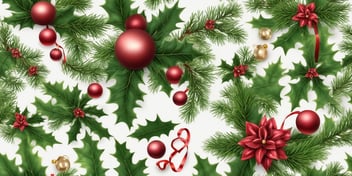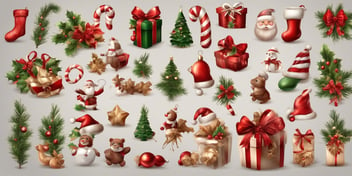- Blog
- Christmas tree
- Discovering the Different Types of Christmas Trees: Which One is Perfect for You?

Ah, the most wonderful time of the year is upon us again! The scent of freshly brewed hot cocoa fills the air, as the jingle of bells and cheerful melodies dance through the streets. As we gather with loved ones to celebrate the magic of Christmas, there's a timeless tradition that takes center stage - the Christmas tree. However, with a myriad of choices available, it can be quite a task to decide which majestic evergreen will grace our homes this year.
But fear not! Join us on a merry journeyas we explore the enchanting world of Christmas trees, uncovering the various types that adorn our living rooms and helping you discover the perfect one that will make your holiday season truly shine.
Why Choosing the Right Christmas Tree Matters
- Selecting the appropriate Christmas tree type can enhance your overall holiday experience.
- The right tree can complement your decorating style, adding to the festive ambiance of your home.
- Different tree varieties offer unique characteristics, such as varying needle retention or fragrance levels. Consider your preferences and needs.
- The right tree can create cherished memories, like the tradition of selecting and decorating it together as a family.
- Choosing a tree that fits your space and lifestyle ensures convenience and reduces potential hazards.
- Take into account factors like tree height, width, and maintenance requirements.
- A well-chosen Christmas tree can bring joy and create a magical centerpiece for your holiday celebrations.
Real vs. Artificial Christmas Trees
Advantages of Real Christmas Trees
Real Christmas trees offer several advantages over their artificial counterparts.
Firstly, real trees provide a natural and authentic holiday ambiance, with their unique scent and the charm of a living tree indoors.
Additionally, real trees are biodegradable, making them a more environmentally friendly choice. They can be recycled into mulch or used for other purposes after the holiday season. Moreover, choosing a real tree supports local tree farms and the economy.
Finally, real trees offer a wide variety of types to choose from, allowing you to find the perfect tree that fits your preferences and style. So, consider the advantages of real Christmas trees when selecting the ideal tree for your holiday celebration.
Advantages of Artificial Christmas Trees
Artificial Christmas trees offer a range of benefits for those seeking convenience and longevity. Firstly, they require minimal maintenance as they don't shed needles or require watering. This saves time and effort during the busy holiday season. Additionally, artificial trees can be reused year after year, making them a cost-effective option in the long run. They are also available in various sizes and styles, allowing you to find the perfect fit for your space and aesthetic preferences. Lastly, artificial trees eliminate the need for cutting down real trees, making them a more environmentally friendly choice.
Popular Christmas Tree Types
Balsam Fir
The Balsam Fir is a popular Christmas tree type known for its pleasant fragrance and vibrant green color. Here are some key points to know about this variety:
- Balsam Fir needles are soft and short, making it easier to decorate and handle.
- This tree has excellent needle retention, staying fresh for a longer duration.
- Balsam Firs have a classic triangular shape, ideal for showcasing ornaments.
- They are often more affordable compared to other tree types.
- Some people prefer the Balsam Fir for its natural aroma that fills the room.
When considering a Balsam Fir, keep in mind that it requires regular watering to maintain its freshness throughout the holiday season. Opting for trees sourced from local farms can also support sustainable practices.
Fraser Fir
The Fraser Fir is one of the most popular Christmas tree types. It features dense foliage and a pleasant scent, making it a favorite choice for many households. Its sturdy branches are perfect for hanging ornaments and lights. The Fraser Fir also has excellent needle retention, meaning it stays fresh for longer, minimizing cleanup. Its narrow shape makes it suitable for smaller spaces. When purchasing a Fraser Fir, look for a tree with vibrant green needles and a strong, straight trunk.
With proper care, this tree can last throughout the holiday season, bringing joy and beauty to your home.
Douglas Fir
The Douglas Fir is a popular choice when it comes to Christmas trees. It boasts soft, dark green needles with a sweet fragrance. One of its main advantages is its excellent needle retention, making it less likely to shed compared to other tree types. The sturdy branches of the Douglas Fir can support heavier ornaments and decorations. It also tends to be more affordable compared to some other varieties.
Additionally, its symmetrical shape and dense foliage make it visually appealing. If you're looking for a classic and reliable Christmas tree, the Douglas Fir is a great option.
Noble Fir
Noble Fir is a popular Christmas tree type known for its sturdy branches and strong fragrance. The dense foliage of its needles makes it a great choice for displaying ornaments. Its bluish-green hue adds a touch of elegance to any holiday décor. The branches are well-spaced, allowing for easy hanging of lights and decorations. The Noble Fir has excellent needle retention, reducing the amount of cleanup throughout the season.
Its symmetrical shape and lush appearance make it a favorite among those seeking a classic and timeless Christmas tree.
Colorado Blue Spruce
The Colorado Blue Spruce is a popular choice for a Christmas tree due to its unique blue-green color and sturdy branches. Its conical shape and dense foliage make it ideal for hanging ornaments and decorations. The sharp needles of this tree help it retain its freshness for a longer period compared to other types. When selecting a Colorado Blue Spruce, look for a tree with vibrant color and dense needle coverage. Keep in mind that this type of tree requires proper watering to prevent drying out.
With its striking appearance and durability, the Colorado Blue Spruce is a great option for those seeking a visually appealing and long-lasting Christmas tree.
Virginia Pine
Virginia Pine is a popular choice among Christmas tree types. Its characteristic short needles and strong branches make it ideal for holding ornaments and decorations. This tree has a pleasant scent that adds to the festive atmosphere. The compact size of the Virginia Pine also makes it suitable for smaller spaces. Its affordability, combined with the easy availability, makes it a practical option for those on a budget.
However, it's important to note that the Virginia Pine requires regular watering to prevent needle drop, and it should be kept away from heat sources to minimize fire risks.
Norway Spruce
The Norway Spruce is a popular choice for Christmas trees due to its classic look and strong branches. Its dark green color and pleasant fragrance add to the festive atmosphere. However, it is important to note that the Norway Spruce has shorter needle retention compared to other tree types, which means it may require more frequent watering. To ensure its longevity, it is recommended to keep the tree away from direct heat sources and regularly check the water level in the stand.
With proper care and maintenance, a Norway Spruce can be a beautiful addition to your holiday decorations.
White Pine
The white pine is a popular choice for Christmas trees due to its soft, feathery needles and pleasant aroma. It has a classic shape and is known for its good needle retention, making it less messy than some other tree types. White pines are also relatively affordable compared to other varieties. One thing to consider is that their branches may not be as sturdy as those of some other trees, so they may be less suitable for heavy ornaments.
However, if you prefer a more natural, rustic look and don't plan on hanging too many decorations, the white pine could be the perfect choice for you.
Choosing the Perfect Christmas Tree for You
Considerations for Different Needs
When choosing a Christmas tree, it's important to consider your specific needs to find the perfect fit. If you have limited space, opt for a slim or tabletop tree. Families with young children or pets may prefer trees with softer, non-shedding needles like the Balsam Fir or Douglas Fir. For those seeking a strong aroma, the Fraser Fir is a great choice. If you desire a tree with sturdy branches for heavy ornaments, the Noble Fir or Colorado Blue Spruce are reliable options. Take into account factors such as tree height, needle retention, and allergies to ensure your Christmas tree suits your specific requirements.
Caring for Your Christmas Tree
Watering and Hydration
Keeping your Christmas tree properly hydrated is vital for maintaining its freshness throughout the holiday season. Ensure the tree's water supply is consistently replenished, as a dry tree can become a fire hazard. Monitor the water level daily and avoid letting it drop below a certain point. As a general guideline, a tree can consume about 1 quart of water per inch of trunk diameter. Consider using a specialized tree stand with a built-in water reservoir for easy watering. Additionally, place the tree away from heat sources to prevent excessive drying. Proper hydration is key to preserving the beauty and longevity of your chosen Christmas tree type.
Proper Placement and Safety
Choose a suitable location for your Christmas tree that is away from heat sources like fireplaces and radiators to minimize the risk of fire hazards. Make sure there is enough space for the tree and any decorations you plan to add. Anchor the tree securely in a tree stand to prevent tipping, especially if you have pets or small children at home. Keep in mind that real trees require frequent watering, so placing them near a water source is practical. Additionally, avoid blocking any exits or obstructing walkways with the tree to maintain a safe environment for everyone.
Disposal Options
When it comes to disposing of your Christmas tree, there are a few options to consider:
- Curbside Pickup: Many municipalities offer curbside pickup services specifically for Christmas trees. Check your local government's website or contact your waste management department for information.
- Recycling Programs: Some communities have recycling programs where you can drop off your tree to be turned into mulch or compost. Research if there are any nearby locations that accept Christmas trees for recycling.
- Mulching: If you have access to a chipper or shredder, you can turn your tree into mulch for your garden. Make sure to remove all decorations and cut the tree into smaller pieces before mulching.
- DIY Projects: Get creative and repurpose your Christmas tree! You can use the branches for wreaths, garlands, or even create rustic-looking ornaments.
Remember, it's important to dispose of your Christmas tree responsibly to minimize waste and environmental impact.
Key takeaways
With the holiday season fast approaching, finding the perfect Christmas tree for your home is a must. There are numerous types of trees to consider, each with its own unique qualities. If you prefer a traditional tree, the popular Fraser fir or the classic Douglas fir might be your best bet. For those looking for something a bit different, the noble fir or the vibrant blue spruce can add a touch of novelty to your festive decorations.
Read On

Exploring the Different Christmas Tree Species: Which One is Right for You?
Ah, the beloved Christmas tree—the focal point of festive cheer, twinkling lights, and cherished...

Different Types of Christmas Trees: Which One Is Ideal for You?
Tis' the season to be jolly and oh-so-decisions! As the holiday cheer engulfs our homes, one...

Discovering Different Kinds of Christmas Trees: Which One is Right for You?
'Tis the season to be jolly! With the holidays right around the corner, it's time to embark on the...